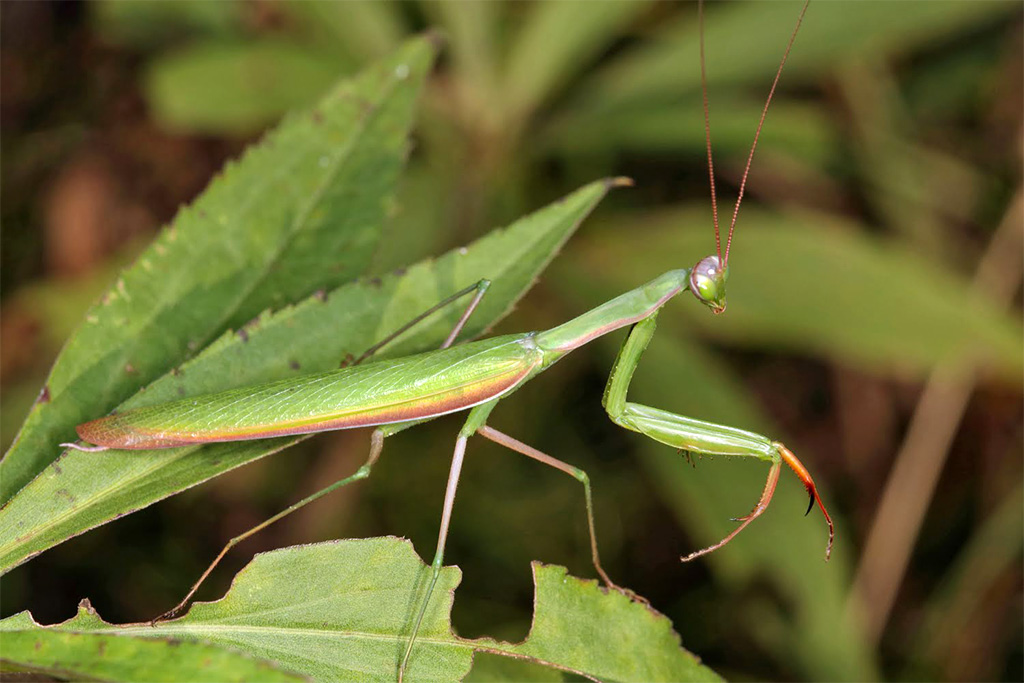Praying mantis deserves a dangerous reputation as the insect that’s tougher than hummingbirds

A European mantis stalks prey on Sept. 11, 2022. (Photo: Tom Murray)
This large and unusual insect is called a praying mantis because, when at rest, its folded front legs make it look as if it is praying. A better name, however, might be preying mantis – this critter is a voracious predator, feeding an almost anything it can catch in its front legs. It closes its spiny front legs together like a pocketknife to capture and grip prey.
In Massachusetts, we can find two kinds: Chinese and European. As the names indicate, neither of these expertly camouflaged insects are native. People introduced the European mantis (Mantis religiosa) and the Chinese mantis (Tenodera aridifolia) to North America in the 1890s to help control insect pests. The European praying mantis, related to termites and cockroaches and not native at all, is the state insect of Connecticut. Go figure.

A European mantis in Mashpee on July 30, 2020. (Photo: Teá Montagna)
The European mantis grows to about 3 inches, while the Chinese mantis can grow up to 5. They can be green or brown depending on environmental conditions.
The size and strength of an adult Chinese mantis allows it to capture surprisingly large prey. People have witnessed Chinese mantises devouring hummingbirds! They sometimes stake out hummingbird feeders, where the mantis pounces on the bird’s head, holding tight with its spiked forelegs. Then it pierces the skull and feeds on brain tissue while the bird is still alive. According to National Geographic, people have recorded 25 incidents of Chinese mantises eating birds (usually ruby-throated hummingbirds) in the Northeast. Mantises will also eat surprisingly large critters including frogs, salamanders, shrews, mice, snakes, and small turtles.

A Chinese mantis on Sept, 14, 2021. Notice the pocketknifelike forelegs for capturing prey. (Photo: Tom Murray)
Mantises have another notorious claim to fame: Up to 30 percent of the time during mating, the female bites off the male’s head and eats it. A study in 2016 found that when this occurs, the female produces twice as many eggs, and the eggs contain significantly more male-derived amino acids. After mating is complete, the female eats the rest of the male’s body.
In the fall after mating, the female lays eggs in a frothy secretion that hardens into a Styrofoam-like egg case. Soon after, the adults die. The eggs overwinter in the egg case, and in the spring, hatch into nymphs. The nymphs look like miniature adults but without wings. They immediately start looking for food, which might include their sisters and brothers. Over the growing season, the nymphs grow by shedding their exoskeleton several times. They reach the adult (winged) state in late summer or fall, but they are not good fliers.

A kestrel captures a mantis meal on Sept. 28, 2022. (Photo: Tom Murray)
Mantises sit and wait or slowly stalk prey with their front legs raised up, ready to clamp down. Their reflexes are fast (milliseconds), so prey escapes rarely. They devour the captured prey with their mouthparts. They are not picky about their prey and will eat nuisance insects as well as beneficial pollinators such as bees, moths and butterflies. They often stake out flowers, so beneficial pollinators are frequent victims.Their surveillance may be aided by a flexible joint that lets mantises swivel its head 180 degrees – the only insect that can accomplish this feat.

A mantis egg case in Great Meadows in Concord on Jan. 20. (Photo: Tom Murray)
Mantises are also the only invertebrate that sees in three dimensions, just like humans. Mantises have two compound eyes that face forward and three small simple eyes for light and motion that can detect movement from 60 feet away. Human three-dimensional vision allows us to perceive depth, but a mantis’s vision allows it to judge how far away prey is as it moves. Human brains have 100 billion neurons to help the brain achieve three-dimensional vision. Mantises have only 1 million neurons, so it is remarkable that they have developed a method to achieve this computationally expensive visual process. Still, they are active during the day because they rely on sight to capture prey.

A mantis, probably searching for a mate, in Somerville’ sDavis Square on Sept. 14. (Photo: Marc Levy)
A mantis is an auditory cyclops because it has only one ear! This ear is in a groove just before the third set of legs. Mantises hear only high-frequency sounds, like the echolocation calls of bats who prey on them. If a mantis hears a bat, it dives to or even into the ground to avoid it.
Mantises spend most of their time close to the ground hiding among plant stems until the August-through-October mating season, when males use their newly grown wings to fly around searching for females. People have spotted mantises all over Cambridge and Somerville, from east to west and north to south. So keep your eyes peeled this time of year. You might find one in a window, on an outdoor statue, near lights or even in a busy city square.
![]()
Reader photo

Cambridge resident Jeffrey Toney encountered this turkey on Harvard Street near Harvard University in July 2022.
![]()
Have you taken photos of our urban wild things? Send your images to Cambridge Day, and we may use them as part of a future feature. Include the photographer’s name and the general location where the photo was taken.
Jeanine Farley is an educational writer who has lived in the Boston area for more than 30 years. She enjoys taking photos of our urban wild things.




Great article. As usual.
If I got a dozen mantises, would they take care of household roaches. Silverfish and ants? If so. Which would be a better bug’hunter Chinese orEuropean?
Asking for a friend.